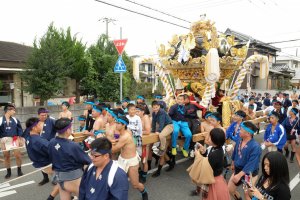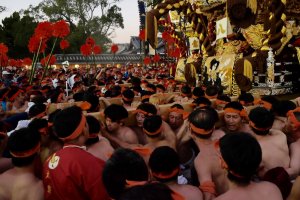Nada no Kenka, or the fighting festival, is celebrated every year on October 14 and 15 in Himeji, South Hyogo Prefecture of the Kansai region. Locals anxiously wait for it. I had the opportunity to experience both days of the festival this year and now I understand why they are so passionate about it. This article describes the first day of the celebration.
Although October 14th main event starts at around 11:00 am, each of the seven districts of Nada’s area exhibits its yatai (decorated float) around their neighbourhood since early morning. Each one weights around 2.5 tons and costs millions of yen. The beautiful wooden carvings, the gold and silver embroiled curtains, and its magnificent details all over helps you understand why they are so expensive.
Once the main event is about to begin, all districts march to Matsubara Hachiman Shrine. The areas are identified by different colours; each with a particular meaning. Pink gets rid of evil spirits, green gives power, red is fire, orange symbolises sweat, vermillion means passion, yellow represents noblemen, and blue is the color of the ocean.
While more than fifty men carry the yatai on their shoulders, four others play the Japanese drum inside of it. It's an honor to have this role, drummers need to practice around twenty years. As they approach the shrine, loud and coordinated voices sing yoyasa, yoyasa. There’s no literal English translation, but its purpose is to cheer and encourage.
As soon as the yatai is outside the shrine, few members of the district run inside carrying a large shide (bamboo pole) with a banner on top. The flag has the name and the corresponding colour of the neighbourhood. Escorting them, there is another group of men carrying a smaller bamboo poles with coloured paper on top. A Shinto priest waits for the yatai to arrive to the main building of the shrine. It then tosses purifying salt to the float and to the members of the district.
Symbolically, the group of men walk with the yatai around the shrine before leaving it at the designated space. As soon as the float is dropped everyone applauds and chants the now famous yoyasa, yoyasa. The team immediately runs to the main building where they try to climb the suzuo (rope below the bell in a Shinto shrine). When one finally succeeds, the already loud chantings grow even louder; the cheers and applauses create a very powerful atmosphere.
After the seven wooden structures are blessed, a taste of the festival’s main event (on October 15th) is gifted to the public. The yatai are jolted against each other. Watching how more than one hundred men carry the heavy floats, gives the illusion of a fight. Seeing it from the top however, it appears more of a float dance than a fight. The men move and rotate the yatai all around while the surrounding crowd enjoys, applauds and cheer. The evident passion of all members in the districts, makes the environment one of celebration and unity.
The first day of the festival is magical. The second day however, is truly unbelievable.































